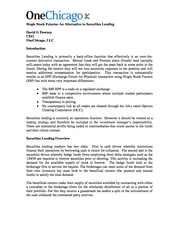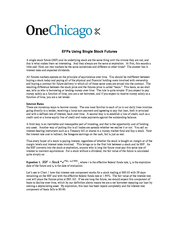Description
2.
Opportunity Cost of Initial Funding, which is the amount of money you have borrowed from yourself. This
is the amount of cash posted as margin against the short stock multiplied by the interest rate you were
earning on that cash and the length of the loan
On the SSF short side interest rate charges include:
1.
Sell Side Income, which is the interest rate carrying cost of the future over the period of the trade, and is
2.
described by SSF Stock * e
, where r is the effective federal funds rate, tx is the expiration
date of the future and t0 is the date of evaluation. This is the federal funds rate multiplied by the price of
the stock;
Income on Initial Funding. This is an interest rate offset.
As you get to post T-bills as your performance bond, you get interest on those funds; and Opportunity Cost of Initial Funding, which is the amount of money you borrowed from yourself. This is the 20% performance bond of the SSF multiplied by the interest rate you were earning on that cash and the length of the loan r *((t x t 0 ) / 360) 3. Comparing Sell Side Total Income Income On Funding Opportunity Cost $14 Sell Side Income $2.03 $12 $10 $0.00 $8 $3.24 $11.00 $6 $4 $5.07 $2 $(1.78) $$(2) $1.82 Total $10.75 Total Stock SSF The OneChicago Advantage Once you start thinking about stock trading in basis points, it is easy to see how and why SSFs have a significant interest rate advantage for both purchases and short sales of stocks, and that is over and above the mechanical difficulties involved with going short on a stock. We cannot claim to know what Einstein would have thought, but he might have wondered where all of these interest rate savings were his whole life. The foregoing is reprint of a column that appeared on RealMoney.com on July 9, 2008 . .
As you get to post T-bills as your performance bond, you get interest on those funds; and Opportunity Cost of Initial Funding, which is the amount of money you borrowed from yourself. This is the 20% performance bond of the SSF multiplied by the interest rate you were earning on that cash and the length of the loan r *((t x t 0 ) / 360) 3. Comparing Sell Side Total Income Income On Funding Opportunity Cost $14 Sell Side Income $2.03 $12 $10 $0.00 $8 $3.24 $11.00 $6 $4 $5.07 $2 $(1.78) $$(2) $1.82 Total $10.75 Total Stock SSF The OneChicago Advantage Once you start thinking about stock trading in basis points, it is easy to see how and why SSFs have a significant interest rate advantage for both purchases and short sales of stocks, and that is over and above the mechanical difficulties involved with going short on a stock. We cannot claim to know what Einstein would have thought, but he might have wondered where all of these interest rate savings were his whole life. The foregoing is reprint of a column that appeared on RealMoney.com on July 9, 2008 . .
Platforms/Exchanges Presentations
+
Platforms/Exchanges Sub Categories














